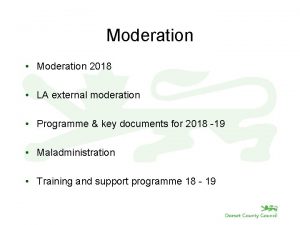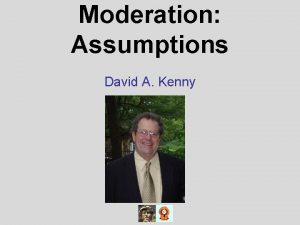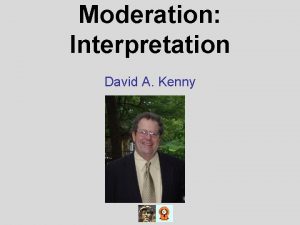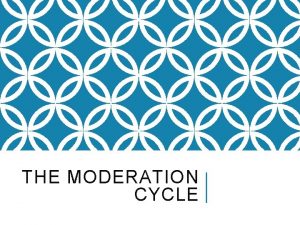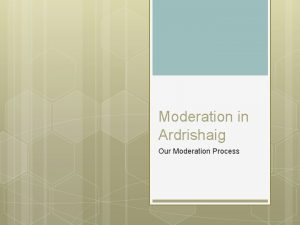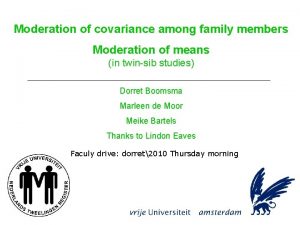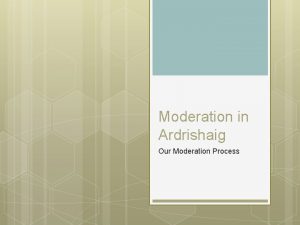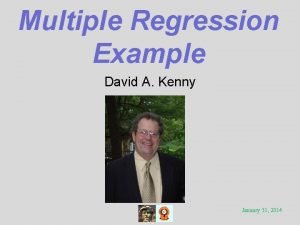Moderation Introduction David A Kenny What Is Moderation
















- Slides: 16

Moderation: Introduction David A. Kenny

What Is Moderation The causal relationship from a causal variable or X to an outcome or Y changes as a function of a moderator or M. – X and M interact to cause Y. – Effect of stress on mood is moderated by gender.

8 The Effect of Stress on Mood Varies by Gender 7 6 Mood 5 Male 4 Female 3 2 1 0 Low High Stress

Causation and Correlation • Need to know causal direction of the X to Y relationship. • If X is a manipulated variable, there should be no relationship between X and M. • Unlike mediation, there is no reason why necessarily X and M should be correlated.

Timing of Measurement • Typically M is measured before or at the same time as X. • Will discuss whether a moderator can be caused by X when we discuss Assumptions.

Statistical Estimation • Typically estimated as the interaction between X and M • Y = a. X + b. M + c. XM + E a = “main effect” of X b = “main effect” of M c = interaction between X and M • Important to include both X and M in the model. • Will discuss the Interpretation in another webinar.

Linearity • Using an product term implies a linear relationship between M and X to Y relationship. • The effect of X on Y changes by a constant amount as M increases or decreases • For example: the effect of Stress on Marital Satisfaction changes by the same amount for every year married.

Statistical Estimation • What was described has been called moderated regression analysis. –One equation –Moderation as an interaction • Problematic alternatives – Separate slopes –Difference in correlations –Median split

Separate Slopes? • M is categorical. • Slope computed for each group in separate analyses. • Difficult to test for moderation and less power. • Is the correct analysis when there are heterogeneous errors.

Separate Correlations? • Categorical moderator. • Compute the correlation between X and Y to determine moderation within each category. • Problem: Differences in X variance. – If men have more variance on X than women, then women would likely have a weaker correlation (restriction in range).

Median Split? • M is measured at the interval level of measurement. • A questionable way to measure and test for moderation is to split M at the mediation and compute slopes for X to Y above and below the split value. • Big loss in power (see Aiken & West).

Flipping X and M • Because XM is an interaction, it can be interpreted as the effect of X depends on M or the that the effect of M depends on X. • Either a different discipline or a rethinking might lead to treating X as the moderator instead of M. • Sometimes this is a useful exercise.

Diagrams of Moderation


Key Resource • Aiken, L. S. , & West, S. G. (1991). Multiple regression: Testing and interpreting interactions. Newbury Park, CA: Sage.

Additional Webinars • • Interpretation Assumptions Effect Size and Power Mod. Text 16
 David kenny mediation
David kenny mediation David kenny sem
David kenny sem Sem model fit
Sem model fit David kenny sem
David kenny sem What is moderation
What is moderation Ounluk
Ounluk Vinco group
Vinco group The watsons go to birmingham kenny
The watsons go to birmingham kenny Kenny rogers the gambler meaning
Kenny rogers the gambler meaning Make a prediction about kenny and franchesca
Make a prediction about kenny and franchesca Is coach carter a true story
Is coach carter a true story Kenny chesney cleveland
Kenny chesney cleveland Farfetch scandal
Farfetch scandal Andy field mediation
Andy field mediation Qian hu kenny yap
Qian hu kenny yap Kenny clamps
Kenny clamps Kenny g louis armstrong
Kenny g louis armstrong

















